Guatemalan vs Celtic Community Comparison
COMPARE
Guatemalan
Celtic
Social Comparison
Social Comparison
Guatemalans
Celtics
1,497
SOCIAL INDEX
12.5/ 100
SOCIAL RATING
305th/ 347
SOCIAL RANK
5,342
SOCIAL INDEX
50.9/ 100
SOCIAL RATING
179th/ 347
SOCIAL RANK
Celtic Integration in Guatemalan Communities
The statistical analysis conducted on geographies consisting of 148,556,905 people shows a substantial positive correlation between the proportion of Celtics within Guatemalan communities in the United States with a correlation coefficient (R) of 0.528. On average, for every 1% (one percent) increase in Guatemalans within a typical geography, there is an increase of 0.005% in Celtics. To illustrate, in a geography comprising of 100,000 individuals, a rise of 1,000 Guatemalans corresponds to an increase of 4.7 Celtics.
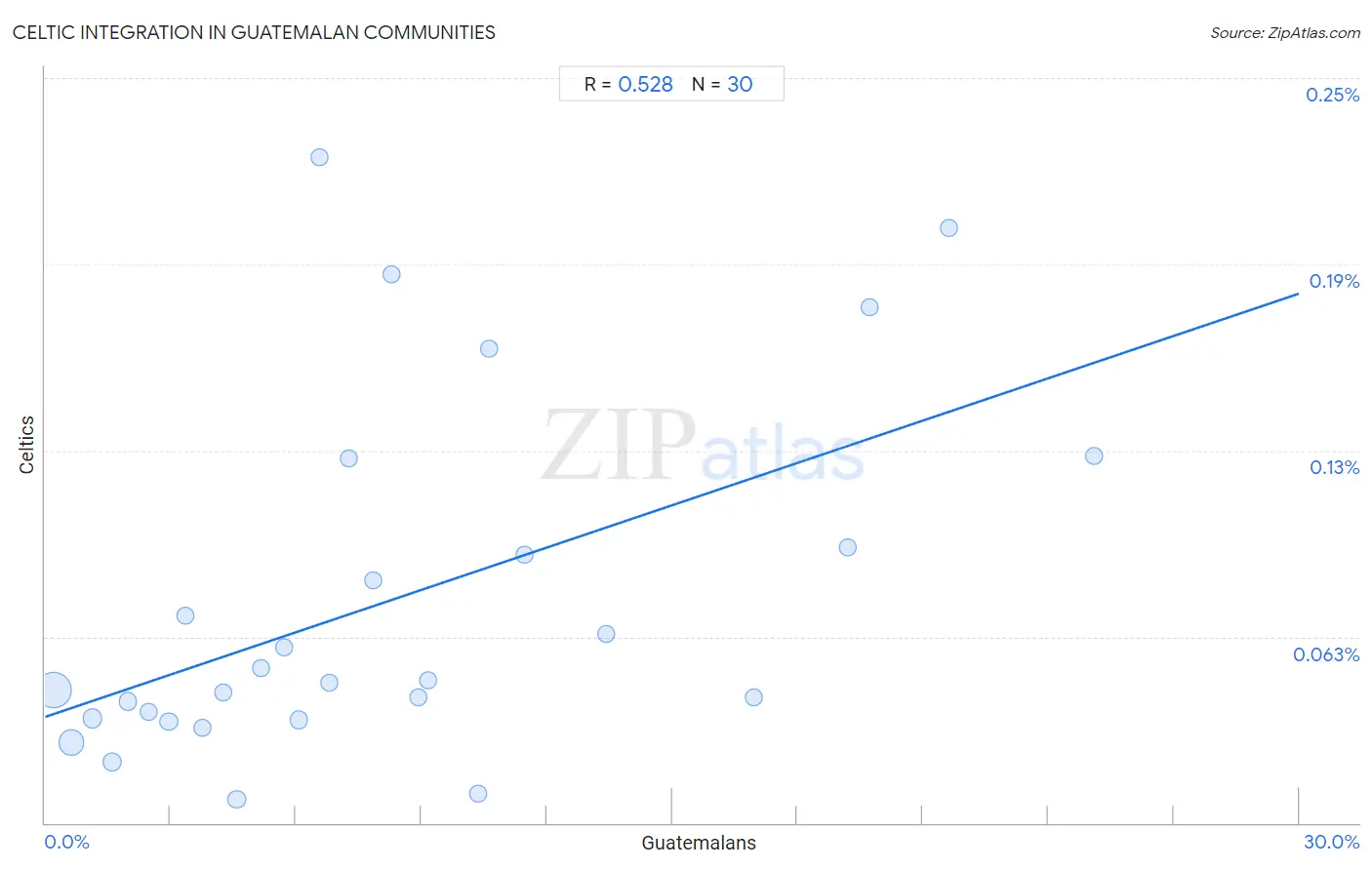
Guatemalan vs Celtic Income
When considering income, the most significant differences between Guatemalan and Celtic communities in the United States are seen in wage/income gap (22.6% compared to 27.3%, a difference of 20.5%), median male earnings ($46,736 compared to $54,242, a difference of 16.1%), and per capita income ($37,766 compared to $43,621, a difference of 15.5%). Conversely, both communities are more comparable in terms of householder income under 25 years ($51,525 compared to $50,447, a difference of 2.1%), median female earnings ($35,695 compared to $38,283, a difference of 7.2%), and median household income ($75,961 compared to $83,193, a difference of 9.5%).

| Income Metric | Guatemalan | Celtic |
| Per Capita Income | Tragic $37,766 | Average $43,621 |
| Median Family Income | Tragic $88,295 | Fair $101,139 |
| Median Household Income | Tragic $75,961 | Fair $83,193 |
| Median Earnings | Tragic $41,205 | Fair $45,732 |
| Median Male Earnings | Tragic $46,736 | Average $54,242 |
| Median Female Earnings | Tragic $35,695 | Tragic $38,283 |
| Householder Age | Under 25 years | Poor $51,525 | Tragic $50,447 |
| Householder Age | 25 - 44 years | Tragic $82,331 | Fair $92,241 |
| Householder Age | 45 - 64 years | Tragic $87,705 | Fair $98,896 |
| Householder Age | Over 65 years | Tragic $54,526 | Average $60,608 |
| Wage/Income Gap | Exceptional 22.6% | Tragic 27.3% |
Guatemalan vs Celtic Poverty
When considering poverty, the most significant differences between Guatemalan and Celtic communities in the United States are seen in married-couple family poverty (7.0% compared to 4.8%, a difference of 47.3%), seniors poverty over the age of 65 (13.5% compared to 9.8%, a difference of 37.8%), and seniors poverty over the age of 75 (14.8% compared to 11.0%, a difference of 34.3%). Conversely, both communities are more comparable in terms of female poverty among 18-24 year olds (20.7% compared to 21.6%, a difference of 4.3%), single female poverty (23.8% compared to 22.7%, a difference of 5.0%), and single male poverty (13.8% compared to 14.5%, a difference of 5.1%).
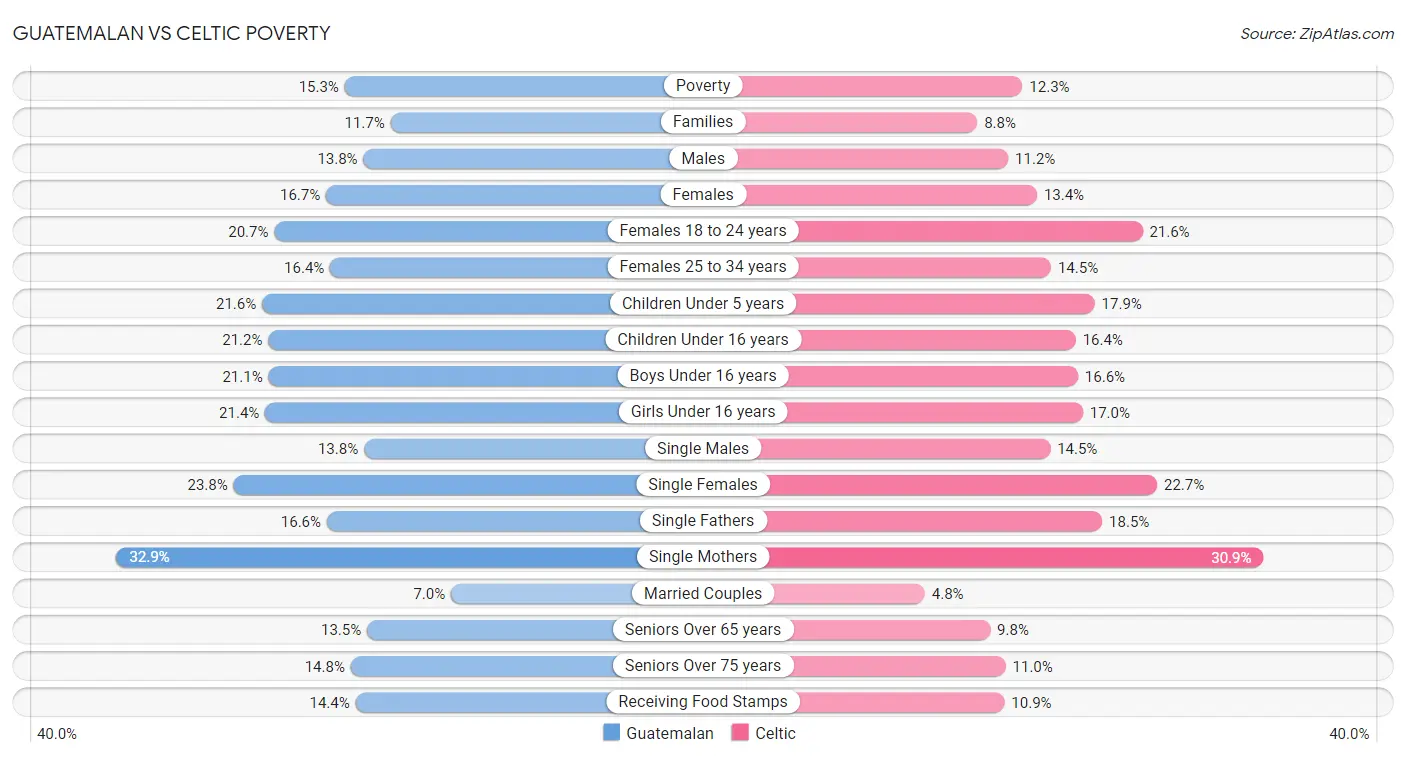
| Poverty Metric | Guatemalan | Celtic |
| Poverty | Tragic 15.3% | Average 12.3% |
| Families | Tragic 11.7% | Good 8.8% |
| Males | Tragic 13.8% | Average 11.2% |
| Females | Tragic 16.7% | Average 13.4% |
| Females 18 to 24 years | Tragic 20.7% | Tragic 21.6% |
| Females 25 to 34 years | Tragic 16.4% | Tragic 14.5% |
| Children Under 5 years | Tragic 21.6% | Poor 17.9% |
| Children Under 16 years | Tragic 21.2% | Fair 16.4% |
| Boys Under 16 years | Tragic 21.1% | Average 16.6% |
| Girls Under 16 years | Tragic 21.4% | Fair 17.0% |
| Single Males | Tragic 13.8% | Tragic 14.5% |
| Single Females | Tragic 23.8% | Tragic 22.7% |
| Single Fathers | Poor 16.6% | Tragic 18.5% |
| Single Mothers | Tragic 32.9% | Tragic 30.9% |
| Married Couples | Tragic 7.0% | Exceptional 4.8% |
| Seniors Over 65 years | Tragic 13.5% | Exceptional 9.8% |
| Seniors Over 75 years | Tragic 14.8% | Exceptional 11.0% |
| Receiving Food Stamps | Tragic 14.4% | Excellent 10.9% |
Guatemalan vs Celtic Unemployment
When considering unemployment, the most significant differences between Guatemalan and Celtic communities in the United States are seen in female unemployment (6.0% compared to 4.9%, a difference of 22.1%), unemployment (5.8% compared to 4.9%, a difference of 18.1%), and unemployment among women with children under 18 years (6.3% compared to 5.4%, a difference of 16.6%). Conversely, both communities are more comparable in terms of unemployment among women with children ages 6 to 17 years (9.3% compared to 9.5%, a difference of 1.2%), unemployment among ages 60 to 64 years (5.2% compared to 5.1%, a difference of 2.8%), and unemployment among ages 25 to 29 years (7.1% compared to 6.9%, a difference of 3.3%).
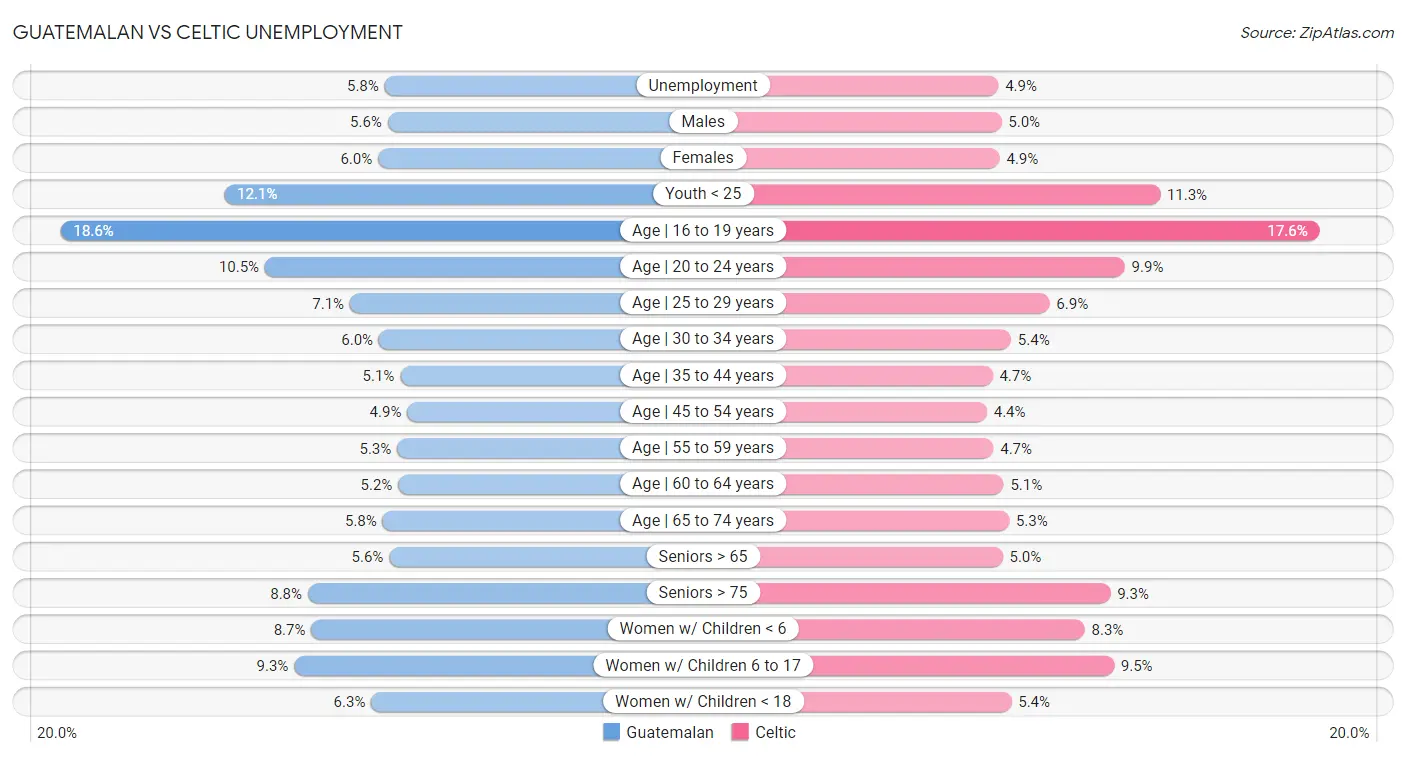
| Unemployment Metric | Guatemalan | Celtic |
| Unemployment | Tragic 5.8% | Exceptional 4.9% |
| Males | Tragic 5.6% | Exceptional 5.0% |
| Females | Tragic 6.0% | Exceptional 4.9% |
| Youth < 25 | Tragic 12.1% | Exceptional 11.3% |
| Age | 16 to 19 years | Tragic 18.6% | Average 17.6% |
| Age | 20 to 24 years | Poor 10.5% | Exceptional 9.9% |
| Age | 25 to 29 years | Tragic 7.1% | Tragic 6.9% |
| Age | 30 to 34 years | Tragic 6.0% | Good 5.4% |
| Age | 35 to 44 years | Tragic 5.1% | Good 4.7% |
| Age | 45 to 54 years | Tragic 4.9% | Excellent 4.4% |
| Age | 55 to 59 years | Tragic 5.3% | Exceptional 4.7% |
| Age | 60 to 64 years | Tragic 5.2% | Tragic 5.1% |
| Age | 65 to 74 years | Tragic 5.8% | Excellent 5.3% |
| Seniors > 65 | Tragic 5.6% | Exceptional 5.0% |
| Seniors > 75 | Fair 8.8% | Tragic 9.3% |
| Women w/ Children < 6 | Tragic 8.7% | Tragic 8.3% |
| Women w/ Children 6 to 17 | Tragic 9.3% | Tragic 9.5% |
| Women w/ Children < 18 | Tragic 6.3% | Good 5.4% |
Guatemalan vs Celtic Labor Participation
When considering labor participation, the most significant differences between Guatemalan and Celtic communities in the United States are seen in in labor force | age 16-19 (35.5% compared to 41.3%, a difference of 16.4%), in labor force | age > 16 (65.6% compared to 63.8%, a difference of 2.7%), and in labor force | age 20-24 (75.3% compared to 77.1%, a difference of 2.4%). Conversely, both communities are more comparable in terms of in labor force | age 20-64 (78.7% compared to 78.7%, a difference of 0.020%), in labor force | age 30-34 (83.7% compared to 84.1%, a difference of 0.38%), and in labor force | age 45-54 (81.2% compared to 81.8%, a difference of 0.73%).

| Labor Participation Metric | Guatemalan | Celtic |
| In Labor Force | Age > 16 | Exceptional 65.6% | Tragic 63.8% |
| In Labor Force | Age 20-64 | Tragic 78.7% | Tragic 78.7% |
| In Labor Force | Age 16-19 | Tragic 35.5% | Exceptional 41.3% |
| In Labor Force | Age 20-24 | Good 75.3% | Exceptional 77.1% |
| In Labor Force | Age 25-29 | Tragic 83.7% | Average 84.7% |
| In Labor Force | Age 30-34 | Tragic 83.7% | Tragic 84.1% |
| In Labor Force | Age 35-44 | Tragic 83.0% | Tragic 83.8% |
| In Labor Force | Age 45-54 | Tragic 81.2% | Tragic 81.8% |
Guatemalan vs Celtic Family Structure
When considering family structure, the most significant differences between Guatemalan and Celtic communities in the United States are seen in single father households (3.0% compared to 2.3%, a difference of 27.3%), single mother households (7.7% compared to 6.1%, a difference of 24.9%), and births to unmarried women (37.1% compared to 33.3%, a difference of 11.5%). Conversely, both communities are more comparable in terms of family households (65.2% compared to 63.8%, a difference of 2.3%), divorced or separated (12.2% compared to 13.0%, a difference of 6.5%), and family households with children (28.9% compared to 26.6%, a difference of 8.5%).

| Family Structure Metric | Guatemalan | Celtic |
| Family Households | Exceptional 65.2% | Tragic 63.8% |
| Family Households with Children | Exceptional 28.9% | Tragic 26.6% |
| Married-couple Households | Tragic 43.3% | Excellent 47.3% |
| Average Family Size | Exceptional 3.40 | Tragic 3.11 |
| Single Father Households | Tragic 3.0% | Average 2.3% |
| Single Mother Households | Tragic 7.7% | Good 6.1% |
| Currently Married | Tragic 42.9% | Exceptional 47.8% |
| Divorced or Separated | Fair 12.2% | Tragic 13.0% |
| Births to Unmarried Women | Tragic 37.1% | Poor 33.3% |
Guatemalan vs Celtic Vehicle Availability
When considering vehicle availability, the most significant differences between Guatemalan and Celtic communities in the United States are seen in no vehicles in household (11.0% compared to 8.1%, a difference of 36.1%), 2 or more vehicles in household (54.1% compared to 59.2%, a difference of 9.3%), and 3 or more vehicles in household (20.1% compared to 21.7%, a difference of 7.9%). Conversely, both communities are more comparable in terms of 4 or more vehicles in household (7.0% compared to 7.1%, a difference of 1.9%), 1 or more vehicles in household (89.2% compared to 92.1%, a difference of 3.3%), and 3 or more vehicles in household (20.1% compared to 21.7%, a difference of 7.9%).

| Vehicle Availability Metric | Guatemalan | Celtic |
| No Vehicles Available | Poor 11.0% | Exceptional 8.1% |
| 1+ Vehicles Available | Poor 89.2% | Exceptional 92.1% |
| 2+ Vehicles Available | Tragic 54.1% | Exceptional 59.2% |
| 3+ Vehicles Available | Excellent 20.1% | Exceptional 21.7% |
| 4+ Vehicles Available | Exceptional 7.0% | Exceptional 7.1% |
Guatemalan vs Celtic Education Level
When considering education level, the most significant differences between Guatemalan and Celtic communities in the United States are seen in no schooling completed (3.5% compared to 1.6%, a difference of 111.9%), doctorate degree (1.4% compared to 1.9%, a difference of 33.6%), and professional degree (3.5% compared to 4.4%, a difference of 26.6%). Conversely, both communities are more comparable in terms of nursery school (96.6% compared to 98.5%, a difference of 1.9%), kindergarten (96.5% compared to 98.4%, a difference of 2.0%), and 1st grade (96.5% compared to 98.4%, a difference of 2.0%).
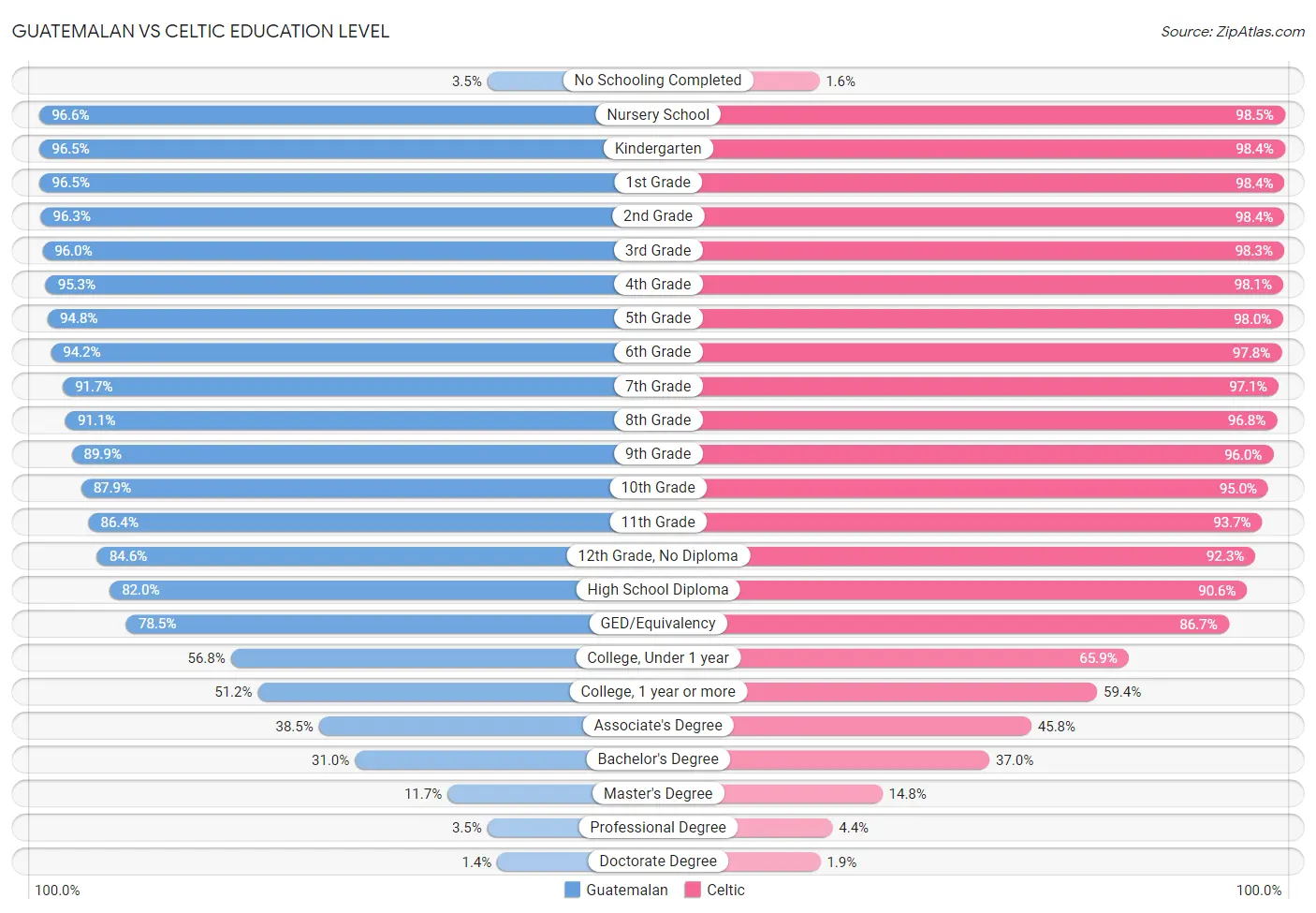
| Education Level Metric | Guatemalan | Celtic |
| No Schooling Completed | Tragic 3.5% | Exceptional 1.6% |
| Nursery School | Tragic 96.6% | Exceptional 98.5% |
| Kindergarten | Tragic 96.5% | Exceptional 98.4% |
| 1st Grade | Tragic 96.5% | Exceptional 98.4% |
| 2nd Grade | Tragic 96.3% | Exceptional 98.4% |
| 3rd Grade | Tragic 96.0% | Exceptional 98.3% |
| 4th Grade | Tragic 95.3% | Exceptional 98.1% |
| 5th Grade | Tragic 94.8% | Exceptional 98.0% |
| 6th Grade | Tragic 94.2% | Exceptional 97.8% |
| 7th Grade | Tragic 91.7% | Exceptional 97.1% |
| 8th Grade | Tragic 91.1% | Exceptional 96.8% |
| 9th Grade | Tragic 89.9% | Exceptional 96.0% |
| 10th Grade | Tragic 87.9% | Exceptional 95.0% |
| 11th Grade | Tragic 86.4% | Exceptional 93.7% |
| 12th Grade, No Diploma | Tragic 84.6% | Exceptional 92.3% |
| High School Diploma | Tragic 82.0% | Exceptional 90.6% |
| GED/Equivalency | Tragic 78.5% | Exceptional 86.7% |
| College, Under 1 year | Tragic 56.8% | Good 65.9% |
| College, 1 year or more | Tragic 51.2% | Average 59.4% |
| Associate's Degree | Tragic 38.5% | Fair 45.8% |
| Bachelor's Degree | Tragic 31.0% | Fair 37.0% |
| Master's Degree | Tragic 11.7% | Average 14.8% |
| Professional Degree | Tragic 3.5% | Average 4.4% |
| Doctorate Degree | Tragic 1.4% | Good 1.9% |
Guatemalan vs Celtic Disability
When considering disability, the most significant differences between Guatemalan and Celtic communities in the United States are seen in disability age under 5 (1.2% compared to 1.7%, a difference of 36.7%), hearing disability (2.8% compared to 3.7%, a difference of 32.4%), and disability age 18 to 34 (6.4% compared to 7.6%, a difference of 19.8%). Conversely, both communities are more comparable in terms of self-care disability (2.6% compared to 2.6%, a difference of 0.58%), vision disability (2.3% compared to 2.4%, a difference of 2.6%), and cognitive disability (17.8% compared to 17.1%, a difference of 3.5%).
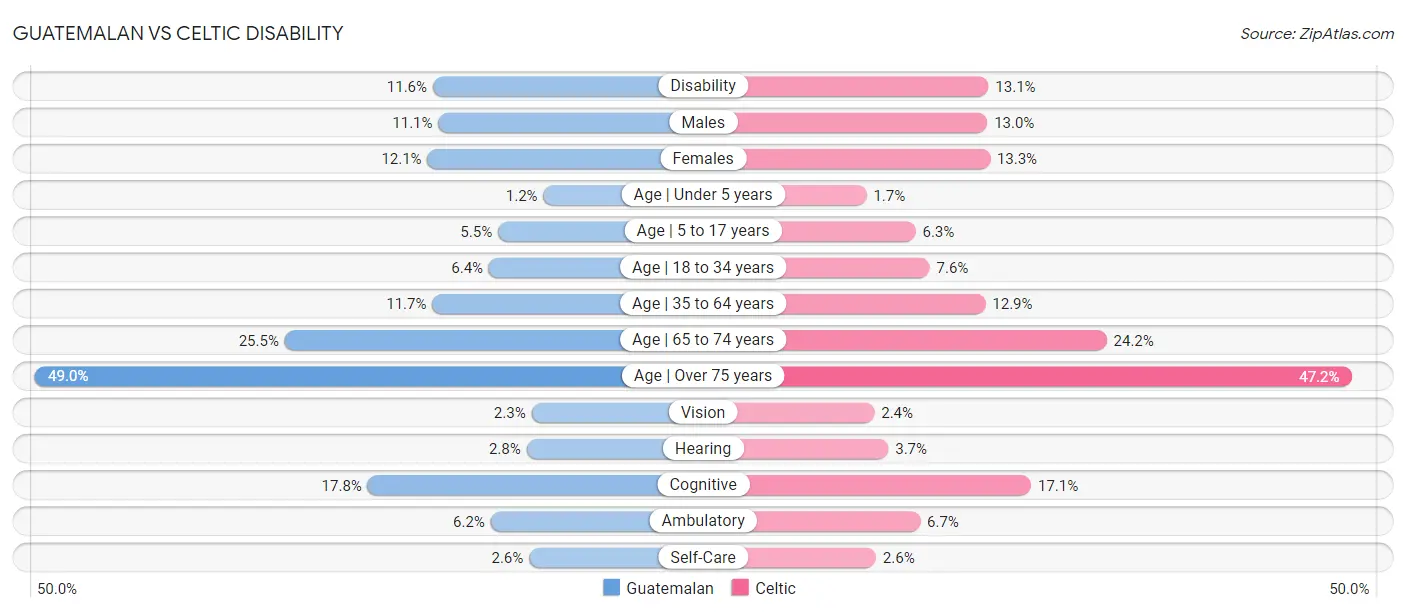
| Disability Metric | Guatemalan | Celtic |
| Disability | Good 11.6% | Tragic 13.1% |
| Males | Good 11.1% | Tragic 13.0% |
| Females | Good 12.1% | Tragic 13.3% |
| Age | Under 5 years | Good 1.2% | Tragic 1.7% |
| Age | 5 to 17 years | Excellent 5.5% | Tragic 6.3% |
| Age | 18 to 34 years | Excellent 6.4% | Tragic 7.6% |
| Age | 35 to 64 years | Poor 11.7% | Tragic 12.9% |
| Age | 65 to 74 years | Tragic 25.5% | Tragic 24.2% |
| Age | Over 75 years | Tragic 49.0% | Average 47.2% |
| Vision | Tragic 2.3% | Tragic 2.4% |
| Hearing | Exceptional 2.8% | Tragic 3.7% |
| Cognitive | Tragic 17.8% | Good 17.1% |
| Ambulatory | Fair 6.2% | Tragic 6.7% |
| Self-Care | Tragic 2.6% | Tragic 2.6% |